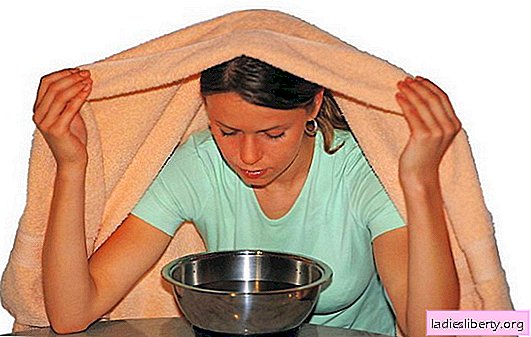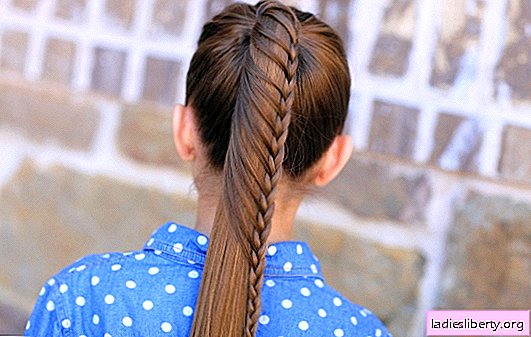
According to the medical encyclopedia of inhalation, a procedure with which it is possible to effectively cure airway inflammation.
Inhalations enable the drug to act directly on the mucous membranes of the respiratory system.
Inhalations at home: indications and contraindications
Local therapy - inhalations are indicated for such ailments as:
• runny nose
• sinusitis
• tonsillitis
• pharyngitis
• bronchitis
• pneumonia
• asthma attack
• allergy to pollen
With the help of the procedure, inflammation of the mucous membrane of the respiratory tract is relieved. In addition, inhalation removes cramping cramps, and promotes better sputum rejection.
Thanks to the simple procedures that were used by our ancestors, you can restore breathing, moisturize the mucous membranes.
As a rule, inhalations at home are steam procedures and treatment with modern devices - inhalers or nebulizers.
In the first case, banal acute respiratory infections are treated at the initial stage, accompanied by a runny nose and dry cough. Steam inhalations affect the upper respiratory tract.
Nebulizers are devices that use medications. Inhalations with a nebulizer treat inflammation of the lower respiratory tract.
Despite the availability and simplicity of this method of therapy, inhalations have their contraindications.
Steam procedures are prohibited when:
1. high body temperature
2. bleeding tendencies
3. hypertension
4. for severe lung diseases
5. cardiovascular ailments
6. allergies to drug components
Inhalations at home: what equipment is needed
For inhalation in any pharmacy, you can easily purchase a nebulizer - a device that means “cloud, fog”. The device allows you to accurately affect some parts of the respiratory system.
Nebulizers are often called simply: inhalers. They are divided into:
• Steamwhich are intended for use of herbs, mineral water.
• Compressor. They make it possible to use any medicines.
• Ultrasonic. Break down the drug into small particles. The advantage of these devices is noiselessness, compactness.
• Electronic mesh.
When choosing the right device, you should focus on the goal of treatment. If airway warming is recommended, then a steam inhaler is the best option.
For a more intensive treatment with the penetration of small particles of the drug into the respiratory tract, an ultrasound device is suitable.
And if ease of use and versatility are important, give preference to a compressor inhaler.
There are devices that operate on batteries, which makes it convenient to carry out the procedure on the road.
Inhalations at home with bronchitis and cough: recipes, composition, features of the procedure
Inhalation with bronchitis and cough helps to defeat the disease in a short time. The procedure not only promotes liquefaction of sputum, but also its separation and removal from the patient's body.
As a rule, inhalations for inflammation of the bronchi and cough are carried out using infusions of medicinal herbs, aromatic oils, as well as medications.
In the absence of a special device, it is advisable to use open containers for hot water or a kettle and funnel.
So, the best and most proven recipes for the preparation of therapeutic compositions for inhalation:
1. Combine 20 g of eucalyptus leaves (pre-chop) and elderberry flowers. Add 5 g of Kalanchoe juice and half a liter of boiling water.
Allow the composition to infuse, warm it up before the procedure and inhale up to 3 times a day.
2. Grind and combine the following medicinal components: licorice root, chamomile, sage, calendula, succession, eucalyptus leaves (15 g each). Brew the composition in a thermos with half a liter of boiling water. Carry inhalation with this composition for 10 minutes up to 4 times a day.
3. Pour in a thermos half a liter of boiling water an excellent anti-inflammatory natural remedy - pine buds (30 g). Add the same amount of chamomile flowers to the mixture. Infuse the composition for about an hour, then spend ten minutes of steam inhalation.
4. Grind and brew in a thermos with a half liter of boiling water a natural antibiotic - yarrow. Add mint (15 g), viburnum bark (20 g). Infuse a healing agent for about an hour and inhale 3 times a day.
5. Sage is considered the best medicinal plant, effectively combating any inflammation of the respiratory tract. Combine sage with hypericum, marigold and chamomile (all 20 g each). Add 25 g of oak bark to the mixture and brew the composition in a thermos with half a liter of boiling water. Follow the procedures for 10-15 minutes daily.
6. Onions and garlic are champions in the fight against any common cold. Pour freshly prepared juice of onion or garlic (1 small spoon) with half a liter of boiling water. Inhalations with this powerful antibacterial agent can be carried out up to 3 times a day (10 minutes).
7. Inhalations at home with bronchitis and cough are good for soda. Dilute a teaspoon of the product in 1 cup of hot water and inhale the healing steam up to 2-3 times a day.
8. Salt is another proven natural substance that effectively treats colds. It is best to use sea salt. In this case, a large one. Dissolve 3 tablespoons of salt in a liter of hot water. Add eucalyptus oil (a few drops) and soda (1 small spoon) to the composition.
Drop the oil after the other components are thoroughly mixed. Inhalations spend 2 times a day until complete healing.
9. Essential oils - in themselves, have a high therapeutic effect. But they are most effective if they are added to ready-made decoctions and infusions of medicinal herbs.
The best inhalations at home for bronchitis and cough are: lavender oil, eucalyptus, pine, fir, juniper.
10. One of the most popular drugs for the treatment of bronchitis and cough is Lazolvan. With its help, inhalations are carried out, diluting sputum, lowering viscosity, contributing to its excretion.
To prepare a medicinal solution, Lazolvan is diluted (in a ratio of 1: 1) with saline.
Inhalation with this medication should not be carried out for more than 5 days. In addition, it is desirable to perform the procedure with the simultaneous administration of antitussive drugs: Broncholitin, Libexin, Codeine.
11. The procedure using mineral water such as Borjomi is indicated for moisturizing the mucous membrane of the respiratory tract. It liquefies sputum, softens catarrhal phenomena.
For inhalation, use non-carbonated mineral water. Pour 4-5 ml of the product into an ultrasonic device and breathe in healing steam for 10 minutes.
If there is no special device, then use an ordinary saucepan (250 ml). Pour water into it, heat to 50ºC. Then, covered with a towel, breathe therapeutic steam for 7 minutes. Perform the procedure often - up to 5-7 times a day.
12. Inhalations with the Golden Star balm - are no less effective for bronchitis and cough. Throw a couple of pieces of balm (very small) in boiling water and breathe healing pairs for 10-15 minutes.
It is advisable to carry out inhalations (with great care, so as not to get burned!) For both children and adults with the first symptoms of the disease. In therapy certain recommendations should be followed:
1. A drug solution is prepared right before the procedure.
2. Inhalations should be performed no earlier than 40 minutes after eating.
3. You can’t talk during the procedure, and you should eat food at least an hour after it.
4. Inhale the solution slowly through the mouth, and exhale through the nose.
5. To achieve the desired result, the course of treatment should be at least 10 procedures. If necessary, it is repeated after 3-4 days.
Inhalations at home with a cold
Runny nose inhalations are the most effective way to relieve cold symptoms safely and easily. What are useful inhalation at home with a cold? They:
• irrigate the entire mucous membrane
• enable medicinal substances to gently and for a long time
• have no side effects
1. Soda solution - the most popular in the treatment of the common cold. Dissolve soda (0.5 tsp) in hot water (2 l) and breathe in healing steam. Remember that with rhinitis, the vapor should be inhaled with the nose, not the mouth. You can only exhale through your mouth.
2. Combine half a teaspoon of sea salt with a glass of hot water. Use the composition as intended.
3. Pour a small spoonful of salt into a glass of water, add 15 drops of sea buckthorn oil. Warm the composition to a temperature of 70ºC and place in the inhaler. Inhale therapeutic vapor for 15 minutes.
Instead of sea buckthorn oil, you can use Kalanchoe juice. Then the mixture must be heated to 50ºC.
4. Acute and chronic rhinitis are effectively treated with the help of coltsfoot, which is prepared as follows: pour 15 g of the plant with a glass of boiling water.
To the solution, you can add a decoction of blackberry leaves, which is prepared from 20 g of the plant and a glass of boiling water. The mixture is boiled over low heat for several minutes. A couple drops of eucalyptus oil should be added to the treatment solution.
5. Take in equal proportions pine buds, eucalyptus leaves, mint. Pour boiling water over everything, let it brew well. Use one more recipe for inhalations at home with a runny nose, which, most likely, is known to everyone. Jacket potato! Cook a couple of tubers with the peel and, bending over the steam, breathe for 10-15 minutes. Be careful not to get burned!
Remember that inhalation with a cold is necessary to moisturize the mucosa. If streams flow from the nose or there are crusts, then the procedure does not make sense.
In addition, you need to know that the only form of inhalation in the common cold is steam procedures. A regular pot of boiling water should be used only for adults or children over 8 years of age.
You can not carry out inhalation with a cold if:
• increased body temperature
• ear pain is felt
• runny nose accompanied by the presence of blood
• if the disease is infectious
With the help of inhalation, you can treat any respiratory diseases. But in any case, before applying this or that method of the procedure, you need to consult a specialist.











